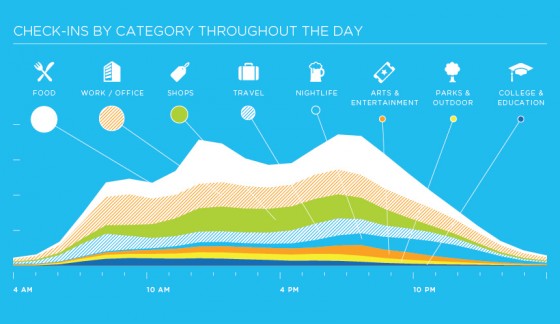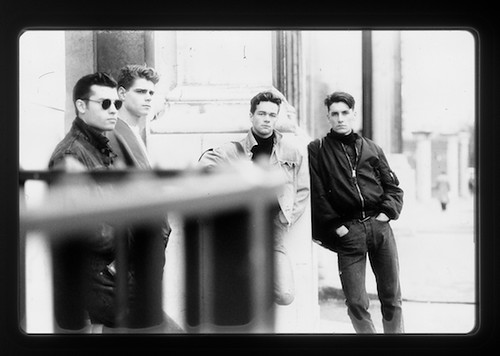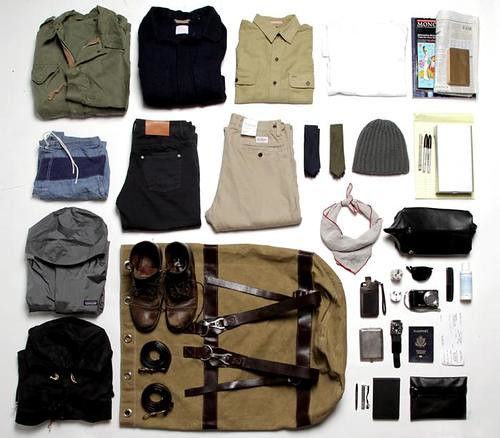Friday, 10:09am
4 February 2011
Check me out
Social media has turned personality into a carefully curated ‘brand’

I recently wrote a post* about living in the era of the over-share, writes Camilla Grey, about how, with so many life-casting tools at our fingertips, we are able to share anything and everything as we go through our day. But just because we can, does it mean we do?
Or do these platforms actually allow us to create a rich brand around who we really are by carefully curating and broadcasting a life that is, in fact, a slightly heightened version of the truth?
Above: Check-ins by category (via foursquare.com).
Most users probably don’t think of themselves and their behaviours in terms of ‘brand’, but that is what social media enables. Apart deviants and sociopaths, we’ve evolved from creating entirely new selves online – like the Barbie and Ken avatars on Second Life. Today, most of us have learned how to portray a pretty accurate interpretation of reality through who we follow, what we ‘like’, what links we share and the content we post.
As social networking platforms proliferate and the lines between our different selves (the work self, the friend self, the family self) blur and break, it is no wonder that we feel compelled to control how the online world sees us. We wouldn’t go to a glamorous party in a pair of old pyjamas, so why would we project anything other than our best selves online?
Above: 1980s Street Style (via howardgrey.com)
One blog has the mission statement: ‘This is a blog intended to trick strangers into thinking my life is more exciting than it actually is.’ The blog may be called ‘Slutever’ but the author’s frank admission is not so shocking. Who isn’t guilty of de-tagging the odd Facebook photo to ensure we look cool, fun and attractive in every picture in our profile?
The location-based check-in services FourSquare and Facebook Places has added an interesting element to personal content curation. The privacy activists may well be concerned about broadcasting their exact location to strangers but, for the self publicist, there are bigger concerns at play, namely where to be ‘seen’ online. The average Londoner could dutifully check in at their tube stop, their place of work and Pret a Manger day-in, day-out, but what’s aspirational or taste-making about that?
Better, surely, only to check-in at the more exciting places. The places that tell your followers something about you and the kind of person you want to be seen as.
Above: Bag contents (via nickelcobalt.tumblr.com).
Furthermore, as we identify the self as ‘brand’ via our allegiances to brands, so companies are reflecting our choices back. More than ever, brands are listening and watching our moves online and rewarding their biggest advocates. From the people who start great Facebook fan pages, to those who become Mayor of their local Starbucks on Foursquare, brands are reaching out and giving them the tools to do the selling for them. As Sheryl Sandberg, the COO of Facebook, said recently, ‘what marketers have always been looking for is trying to get you to sell things to your friends.’
From the Middle Eastern beads found in ancient burial sites in Suffolk, to the tribal people of Papua New Guinea using Pentel pens as nose decorations, to the young people of Berlin whose first goal, once the wall came down, was ‘to eat a Big Mac’, we have used trading, shopping and brands as a way to enlarge our sense of self. So, is this digital age turning us all into products? Or is it simply another platform on which to communicate a very basic human urge – self-expression? Are the selves that we can create and control online more ‘ourselves’ than their real life counterparts?
* See ‘Living in the era of the over-share’ on the Moving Brands website.
Eye magazine is published quarterly for professional designers and students. It’s available from all good design bookshops and online at the Eye shop, where you can buy subscriptions and single copies. For a glimpse of the current one, no. 78, see Eye before you buy on Issuu, or bit.ly/Eye78contents.


